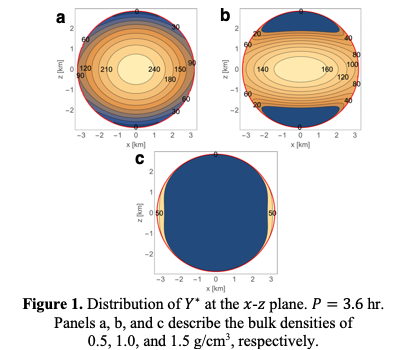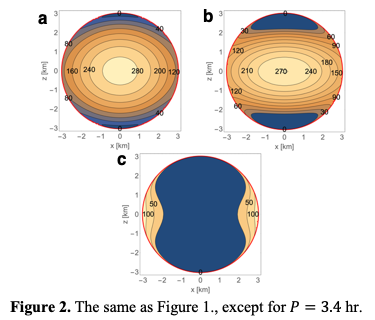Mass-shedding Activities of Asteroid (3200) Phaethon Enhanced by Its Rotation - Implication to Asteroid Pairs
- Auburn University, Department of Aerospace, United States of America (rzn0040@auburn.edu)
Introduction:
Asteroid (3200) Phaethon, a possible source of the Geminid meteoroid stream (i.e. [1]), has been active during perihelion passages [2,3]. Taylor et al. [4] reported that Phaethon might be an oblate shape with ~6 km in diameter with an equatorial ridge, or known as a top-shaped asteroid. Phaethon is currently spinning at a rotation period of 3.6 hr. The radar albedo is reported to be the lowest among the cataloged near-Earth asteroids [5], implying that its spectral type is consistent with B-type [4].
The activities of Phaethon are considered to have been triggered by thermal waves at its perihelion passages [2,3]. We hypothesize that such activities may have been further enhanced by fast rotation, which helped structural failure on the surface or in the interior to induce mass-shedding that developed the Geminid meteoroid stream and recently observed dust tails.
Semi-analytical model:
We model Phaethon as a triaxial ellipsoid with the same oblateness as Bennu, based on the earlier works [6,7]. We assume that Phaethon’s structure is uniform. We consider the bulk density to be range between 0.5 g/cm3 and 1.5 g/cm3, consistent with that of B-type asteroid [8]. Similar to [7,9], we first apply a technique by Dobrovolskis [10] and Holsapple [11] to provide the stress field in a triaxial ellipsoid uniformly spinning at spin period of P. Then, the Drucker-Prager yield criterion [12] is applied to determine the structural failure condition. We compute the minimum cohesive strength that can prevent structural failure of a given element, and denote it as Y*.
Results:
We plot the distribution of Y* at the x-z plane for different bulk densities in Figure 1. For the case of ρ = 0.5 g/cm3, Y* is greater than 0 everywhere except the pole region. The interior exhibits higher Y* than the surface, indicating that the interior is more sensitive to structural failure than the surface (Panel-a). For the case of ρ = 1.0 g/cm3, the interior similarly exhibits Y* in the major regions (Panel-b). For the case of ρ = 1.5 g/cm3, unlike the other two cases, the interior has Y* = 0 except for the surface condition (Panel-c).
Discussions:
Generation of dust tails at present
At the current spin period of 3.6 hr, the body is sensitive to structural failure regardless of the bulk density and thus needs cohesive strength to maintain its shape. The derived cohesive strength is less than ~50 Pa - ~260 Pa. We interpret this sensitivity as a potential enhancement of mass-shedding. If the structure of Phaethon is perturbed by, for example, thermal waves, rotationally driven reshaping can be triggered.
A possible source of the Geminid meteoroid stream
We expect that Phaethon’s deformation mode is to become more oblate [7]. Therefore, Phaethon may have been less oblate and spinning faster before deformation at an earlier stage. The stress condition in the interior should be more severe in the past than at present due to faster spin. If Phaethon is a sphere before the deformation event, the original spin period should be 3.4 hr for this body to reach the current conditions. This spin period is close to or above the critical spin period of the original body. Figure 2 shows larger Y*, leading to higher structural sensitivity. This implies that failure at a shorter spin period is more significant than that at a longer spin period, and thus more materials can be shed [7].
We propose a possible evolution scenario of Phaethon (Figure 3). Phaethon was originally less oblate and spinning at a shorter spin period than the current period. This stage is before the Geminid meteoroid stream was generated. Because the centrifugal forces may have been severer, the reshaping process caused mass-shedding at large-scale, which may become a source of the Geminid meteoroid stream. Then, the current oblate shape is a remnant of earlier reshaping activities. Because the oblateness evolved, the rotation slowed down. The structure is less sensitive to failure but still around the structural limit. Thus, under similar perturbations, rotationally driven failure can be triggered. At this point, however, the centrifugal effect is less significant, the magnitude of mass-shedding is less intense than that in the past. This scenario may consistently explain the history of Phaethon. When the precursor body is less oblate and at high spin, it generates a large mass-shedding event, which can be interpreted to be the source of the Geminid meteoroid stream. Even after such an event, Phaethon still can experience mass-shedding at small-scale, which may be triggered by thermal waves, because of the structural sensitivity to failure.
Phaethon, 2005 UD, and 1999 YC
Asteroid pairs share similar heliocentric orbits, which cannot be random coincidences, and generally share common physical properties [13]. Phaethon has also been claimed to be linked with two other asteroids, (155140) 2005 UD and (225416) 1999 YC [14,15]. Devogele et al. [16] recently reported a physical link (rare spectroscopic and polarimetric similarities) between Phaethon and 2005 UD. If Phaethon truly pairs with these asteroids, the discussed scenario above may also imply their formation processes. If the parent body also has high spin and structural sensitivity, it can experience large-scale failure and break up to multiple elements, one of which is Phaethon, which had further failure events including both large events (maybe related to the Geminid stream source) and smaller events. It is important to note, however, that there still remain questions regarding their dynamical criteria to formally consider them as asteroid pairs (i.e. [17]).


Acknowledgments: RN and MH acknowledge support from NASA/Solar System Workings (NNH17ZDA001N/80NSSC19K0548) and Auburn University/Intramural Grant Program.
References: [1] Whipple(1983) IAUC,3881 [2] Jewitt & Li(2010) AJ,140 [3] Li & Jewitt(2013) AJ,145 [4] Taylor et al.(2019) PSS,167 [5] Neese et al.(2012) NASA-PDS [6] Barnouin et al.(2019) NatGe,12 [7] Hirabayashi(2015) MNRAS,454 [8] Carry et al.(2012) PSS,73 [9] Hirabayashi et al.(2015) AJ,808 [10] Dobrovolskis(1982) Icarus,52 [11] Holsapple(2001) Icarus,154 [12] Chen & Han(1988) Plasticity for Structural Engineers [13] Pravec et al.(2019) Icarus,333 [14] Ohtsuka et al.(2005) CBET,283 [15] Kasuga & Jewitt(2008) AJ,136 [16] Devogele et al.(2020) PSJ,1 [17] Ryabova et al.(2019) MNRAS,485
How to cite: Nakano, R. and Hirabayashi, M.: Mass-shedding Activities of Asteroid (3200) Phaethon Enhanced by Its Rotation - Implication to Asteroid Pairs, Europlanet Science Congress 2020, online, 21 September–9 Oct 2020, EPSC2020-540, https://doi.org/10.5194/epsc2020-540, 2020

